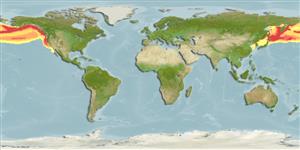Common names from other countries
Elasmobranchii (haaien en roggen) (sharks and rays) >
Lamniformes (Mackerel sharks) >
Lamnidae (Mackerel sharks or white shark)
Etymology: Lamna: From the Greek lamia, a large and voracious shark, originally from Lamia in Greek mythology, daughter of King Belos, who revenged the murder of her children by killing the children of others, and who behaved so cruelly that her face turned into a nightmarish mask. (See ETYFish); ditropis: di-, from dis (L.), in two; tropis (Gr.), keel, i.e., double-keeled, referring to the rudder-like projections on either side of tail. (See ETYFish).
More on authors: Hubbs & Follett.
Environment: milieu / climate zone / depth range / distribution range
Ecologie
marien; oceanodroom (Ref. 51243); diepte 0 - 650 m (Ref. 50550), usually 0 - 152 m (Ref. 55221). Boreal; 66°N - 22°N, 120°E - 115°W
North Pacific: Japan, Korea, and the Sea of Okhotsk to the Bering Sea and southward to southern California, USA (Ref. 247) and Baja California, Mexico (Ref. 9253).
Lengte bij maturiteit / Grootte / Gewicht / Leeftijd
Maturity: Lm ? range ? - 221 cm
Max length : 305 cm TL mannelijk / geslacht onbekend; (Ref. 247); common length : 180 cm TL mannelijk / geslacht onbekend; (Ref. 9988); max. gepubliceerd gewicht: 175.0 kg (Ref. 9988); max. gerapporteerde leeftijd: 27 Jaren (Ref. 119696)
Dorsale stekels (totaal): 0; Dorsale zachte stralen (totaal): 0; Anale stekels 0; Anale zachte stralen: 0. First dorsal fin uniformly dark, no light rear tip; ventral surface of body white with dusky blotches (Ref. 247).
A coastal-littoral and epipelagic shark that prefers boreal to cool temperate waters, from the surface to at least 152 m, and is common in continental offshore waters but range inshore to just off beaches. Occurs singly or in schools or feeding aggregations of several individuals; feeds on fishes (Ref. 247). Seasonally migratory (following food prey) and segregate by age and sex where adults move further north than young (Ref. 58085). Ovoviviparous, embryos feeding on yolk sac and other ova produced by the mother (Ref. 50449). With up to 4 young in a litter (Ref. 247). Fast swimmer (Ref. 9988). Potentially dangerous but has never or seldom been implicated in human attacks (Ref. 247). Causes considerable damage to commercial catches and gear (Ref. 6885). Utilized fresh, dried or salted, and frozen; fins, hides and livers are also used, with fins having particular value; can be broiled and baked (Ref. 9988). Reported to attain at least 27 years of age and reach maximum depth of at least 792 m (in Ref. 119696).
Exhibit ovoviparity (aplacental viviparity), with embryos feeding on other ova produced by the mother (oophagy) after the yolk sac is absorbed (Ref. 50449). Litter size is up to 4 young (Ref. 247). Distinct pairing with embrace (Ref. 205).
Compagno, L.J.V., 1984. FAO Species Catalogue. Vol. 4. Sharks of the world. An annotated and illustrated catalogue of shark species known to date. Part 1 - Hexanchiformes to Lamniformes. FAO Fish. Synop. 125(4/1):1-249. Rome, FAO. (Ref. 247)
Status op de Rode Lijst van het IUCN (Ref. 130435)
CITES (Ref. 128078)
Not Evaluated
Gevaar voor de mens
Traumatogenic
Gebruik door de mens
Visserij: van minder commercieel belang; sportvis: ja
Meer informatie
ReferentiesAquacultuurAquacultuurprofielKweeklijnenGeneticaElectrophoresesErfelijkheidZiektesVerwerkingMassaconversie
Tools
Speciale rapporten
Download XML
Internetbronnen
Estimates based on models
Preferred temperature (Ref.
115969): 1.7 - 8.7, mean 4.7 (based on 832 cells).
Fylogenetische diversiteitsindex (Ref.
82804): PD
50 = 0.7813 [Uniqueness, from 0.5 = low to 2.0 = high].
Bayesian length-weight: a=0.00933 (0.00405 - 0.02151), b=3.04 (2.84 - 3.24), in cm Total Length, based on LWR estimates for this (Sub)family-body shape (Ref.
93245).
Trofisch niveau (Ref.
69278): 4.5 ±0.80 se; based on food items.
Weerstandsvermogen (Ref.
120179): Zeer laag, minimale populatieverdubbelingstijd meer dan 14 jaar (Fec=4).
Fishing Vulnerability (Ref.
59153): High vulnerability (59 of 100).
